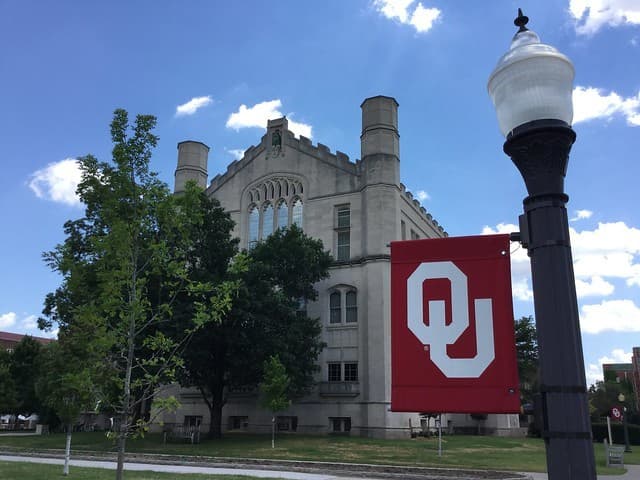
Higher Education
Mike Brake | May 15, 2019
Separate but equal at OU
Mike Brake
The battle for integration for black Americans and other minorities lasted for more than 150 years and, on some fronts, continues today. That’s why it is so alarming to many observers of higher education that on many campuses today, things from student residence halls to graduation ceremonies have been increasingly balkanized by race or ethnicity.
“Separate But Equal Again: Neo-Segregation in American Higher Education” is the ominous title of a series of case studies launched May 1 by the National Association of Scholars (NAS). The first report, authored by Peter W. Wood and Dion J. Pierre, is titled “Neo-Segregation at Yale.”
NAS has also provided a database of neo-segregation at 173 other colleges and universities, including the University of Oklahoma. In virtually all of the 173 institutions, NAS found that black students, Latino students, and members of other minority groups have demanded and been granted separate accommodations in a variety of ways.
At OU, for example, there are separate academic departments for African and African-American, Latino, and Native American studies. The university has a Native American Cultural Center and an American Indian Student Life organization.
High school students visiting the OU campus who identify as Native Americans have a separate welcoming track. The colleges of engineering and business have formal diversity programs that grant scholarships and mentor students on the basis of race. And both Native American and black students are recognized at separate and segregated graduation and achievement ceremonies.
OU does not have segregated residence halls, but the NAS study found many campuses that do. In fact, it is possible for members of some minorities to visit, enroll in, attend, study at, and graduate from many American colleges and universities without ever being exposed except in the most superficial way to students of different backgrounds.
Of the 173 institutions studied by NAS, almost half reported sponsoring segregated residence halls. Three-fourths held some form of racially separate graduation or recognition ceremonies. Virtually all boasted distinct ethnic studies departments or curriculum tracks.
Economist Richard Vedder, writing in Forbes, noted that one asset of the traditional college campus was its forced exposure to others.
“The idea is people are more tolerant, more understanding, of alternative perspectives when they are exposed to individuals markedly different from themselves. Yet having all-black dorms … is anti-diversity. In an Orwellian twist the diversity coordinators are stifling interactions between people of different races,” Vedder said.
Pierre said his research traced neo-segregation on campuses to the turbulent 1960s when more minority students began seeking college educations, but were often poorly prepared for the rigors of college work.
“The rest of the country left the 1960s thinking that Dr. King had basically settled things, that we were to be a colorblind society. But much of black America seemed to take a very different message from that period. They sought racial separation.” —Dion J. Pierre
The civil rights movement spawned affirmative-action programs which did not always serve their supposed beneficiaries well, he said.
“Students were often selected without regard for their academic credentials,” Pierre noted. “There was a need to remediate many poorly prepared students and as a result too many of them pulled away.” Those struggling students often sought the company of peers with the same issues. Colleges and universities responded to their demands by creating race-based dorms or, in some cases, moved to water down the curriculum by creating entire ethnic-studies academic departments where minorities could further wall themselves off from the rest of the campus.
“The rest of the country left the 1960s thinking that Dr. King had basically settled things, that we were to be a colorblind society,” Pierre said. “Much of black America seemed to take a very different message from that period. They sought racial separation.”
While campuses have always featured student groups that tend to stick together, like fraternities and sororities, the overriding mission of higher education—to prepare young adults for citizenship and full membership in society—usually superseded those half-hearted efforts at separatism. Colleges and universities have always stressed the concept of a campus-wide community. The neo-segregation found by the NAS study contradicts that concept.
OU’s website lists five goals in the area of diversity and inclusion:
- Cultivate an inclusive campus climate.
- Improve recruitment, hiring, and retention of faculty and staff from historically underrepresented groups.
- Improve recruitment and retention of graduate and undergraduate students from historically underrepresented groups.
- Create an enhanced learning environment based on diversity and inclusion.
- Strengthen institutional infrastructure to achieve diversity goals.
Those goals include two mentions of inclusion, but the creation of racially distinct organizations, programs, and events all seem to contradict that aspiration.
Pierre said such efforts predispose too many young members of minority groups to leave college and enter the workplace with an image of themselves as forever separate and distinct, and not in a good way.
“I don’t think these students are being prepared for the real world,” Pierre said.
Mike Brake
Contributor
Mike Brake is a journalist and writer who recently authored a centennial history of Putnam City Schools. A former reporter at The Oklahoman (his coverage of the moon landing earned a front-page byline on July 21, 1969), he served as chief writer for Gov. Frank Keating and for Lt. Gov. and Congresswoman Mary Fallin. He has also served as an adjunct instructor at OSU-OKC, and currently serves as public information officer for Oklahoma County Commissioner Brian Maughan.